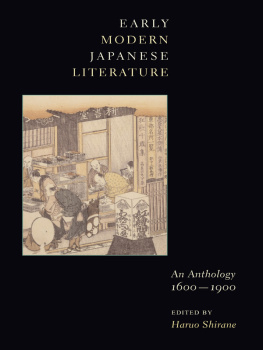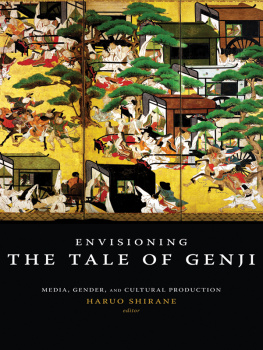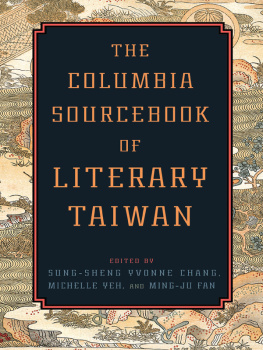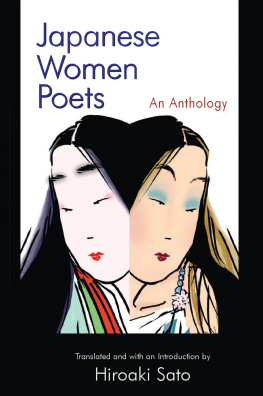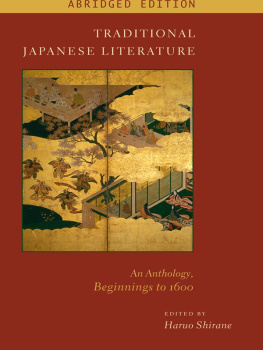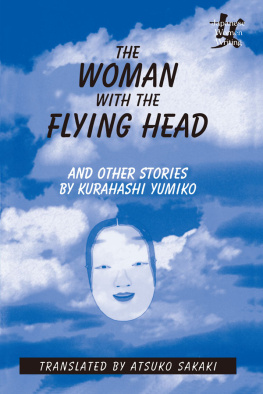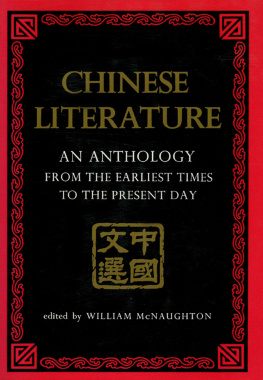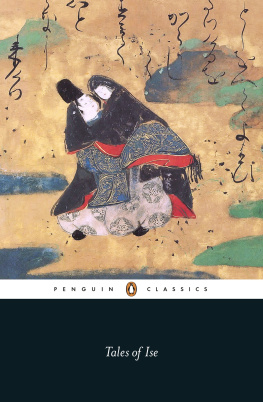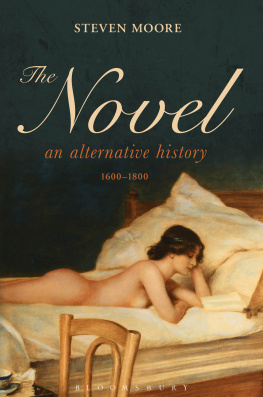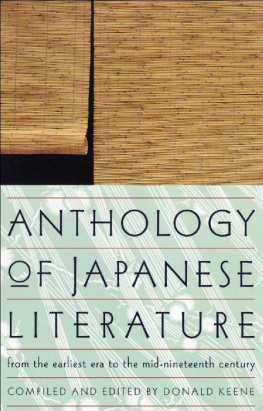Early Modern Japanese Literature
TRANSLATIONS FROM THE ASIAN CLASSICS
Translations from the Asian Classics
EDITORIAL BOARD
Wm. Theodore de Bary, Chairman
Paul Anderer
Irene Bloom
Donald Keene
George A. Saliba
Haruo Shirane
David D. W. Wang
Burton Watson
Early Modern Japanese Literature
AN ANTHOLOGY, 16001900
Edited with Introductions and Commentary by Haruo Shirane
TRANSLATORS
James Brandon, Michael Brownstein, Patrick Caddeau, Caryl Ann Callahan, Steven Carter, Anthony Chambers, Cheryl Crowley, Chris Drake, Peter Flueckiger, Charles Fox, C. Andrew Gerstle, Thomas Harper, Robert Huey, Donald Keene, Richard Lane, Lawrence Marceau, Andrew Markus, Herschel Miller, Maryellen Toman Mori, Jamie Newhard, Mark Oshima, Edward Putzar, Peipei Qiu, Satoru Saito, Tomoko Sakomura, G. W. Sargent, Thomas Satchell, Paul Schalow, Haruo Shirane, Jack Stoneman, Makoto Ueda, Burton Watson

COLUMBIA UNIVERSITY PRESS
NEW YORK
Columbia University Press wishes to express its appreciation
for assistance given by the Japan Foundation toward the cost of publishing this book.
Columbia University Press wishes to express its appreciation for assistance given by the Pushkin Fund toward the cost of publishing this book.
Columbia University Press
Publishers Since 1893
New York Chichester, West Sussex
cup.columbia.edu
Copyright 2002 Columbia University Press
All rights reserved
E-ISBN 978-0-231-50743-1
Library of Congress Cataloging-in-Publication Data
Early modern Japanese literature : an anthology, 16001900 / [edited with introduction by Haruo Shirane].
p. cm.(Translations from the Asian classics)
Includes bibliographical references and index.
ISBN 0-231-10990-3 (cloth : alk. paper)
I. Shirane, Haruo, 1951II. Series.
PL782.E1 E23 2002
895.608003dc21
2001053725
A Columbia University Press E-book.
CUP would be pleased to hear about your reading experience with this e-book at .
This anthology, one of two planned volumes of Japanese literature from the ancient period through the nineteenth century, brings to the reader carefully chosen examples of literature from the Edo period (16001867). Except for such late-seventeenth-century writers as Saikaku, Bash, and Chikamatsu, the three centuries of early modern Japanese literature have often been neglected by Western readers, and most of the texts here have been translated for the first time. It is my hope that this volume will stimulate interest in one of the most exciting periods in world literature.
This book pays particular attention to gesaku (playful writing), the popular literature of the late eighteenth and early nineteenth centuries, which includes dangibon, kyka, senry, kibyshi, sharebon, yomihon, kokkeibon, gkan, and ninjbon. Also integral to early modern culture were the poetry and prose written in Chinese or classical Japanese by those in the literati (bunjin), Chinese studies (kangaku), and nativist studies (kokugaku) movements that came to the fore in the eighteenth century and are well represented here. The anthologys focus on these high genres, especially poetics and literary treatises, reveals their close connection to the popular literature and culture.
Nine selections from jruri (puppet theater) and kabuki by major playwrights are an important part of this book as well. Today in Japan, jruri and kabuki plays are rarely viewed in their entirety. Instead, favorite scenes or acts are performed, often as a medley. This book takes the same approach, thereby allowing the reader to sample a wide variety of plays. The jruri and kabuki selections also were chosen to demonstrate their close connection to the fiction of this period.
Early modern Japanese fiction was accompanied by pictures that existed in a dialogic relationship to the printed text. In this anthology, I have tried to create the same relationship and provide commentary on the images. The drama selections likewise include both photographs from modern performances and Edo-period ukiyo-e and print illustrations.
Much of Japanese literature, particularly the poetry, is highly allusive and elliptical. Consequently, considerable effort has been made not just to translate important and interesting texts but also to offer critical introductions to the various genres, sociocultural phenomena, and authors. Almost all the poetry is accompanied by commentary in the footnotes. Except where indicated, I have written all the introductions and commentaries, and I bear full responsibility for the accuracy and quality of the translations.
This anthology owes its existence to Jennifer Crewe, editorial director at Columbia University Press, who many years ago urged me to take on this project. Because of various other commitments, however, I did not begin working on it seriously until 1997. Since then, I have accumulated many debts.
My greatest debt is to Chris Drake, with whom I had long discussions about the texts, who took on a lions share of the translations, and, indeed, without whom this anthology would not exist. A number of scholars in Japan gave generously of their time, particularly Horikiri Minoru, Hori Nobuo, Ibi Takashi, Kawamoto Kji, Kurozumi Makoto, Momokawa Takahiro, Nagashima Hiroaki, Ogata Tsutomu, oka Makoto, Shirakura Kazuyoshi, Suzuki Jun, and Torii Akio. My gratitude goes as well to Lewis Cook, Andrew Gerstle, Howard Hibbett, Donald Keene, Lawrence Kominz, Lawrence Marceau, Mark Oshima, Thomas Rimer, Edward Seidensticker, Tomi Suzuki, and the anonymous readers who provided invaluable feedback.
Many thanks go to my graduate studentsparticularly Anne Commons, Cheryl Crowley, Torquil Duthie, Peter Flueckiger, Christina Laffin, Herschel Miller, Jamie Newhard, Satoru Sait, Tomoko Sakomura, Michael Scanlon, and Akiko Takeuchi, all of whom assisted with the manuscript at various stages. I-Hsien Wu checked the pinyin, and Wei Shang helped with the Chinese references. Special thanks go to Tomoko Sakomura, who did extensive research on and wrote the legends for the ukiyo-e prints and for the kana-zshi, jruri, late ukiyo-zshi, literati, kibyshi, gkan, late yomihon, and late kabuki illustrations. Melissa McCormick and Barbara Ford assisted with the illustrations. I am grateful to Sakaguchi Akiko, who helped obtain for me the illustrations from the National Theatre in Tokyo. Barbara Adachi, who recently donated her jruri collection to C. V. Starr East Asian Library at Columbia University, allowed me to use her superb photographs, and Amy Heinrich, the director of the library, provided much assistance with the photographs and other matters. Mihoko Miki, the Japanese studies librarian at the C. V. Starr Library, obtained important materials for this book. Yuiko Yampolsky helped me in many ways. Winifred Olsen was an invaluable editor and consultant for the first draft. Margaret B. Yamashita was a superb copy editor. Irene Pavitt at Columbia University Press provided invaluable advice.
My thanks to all the translators for their contributions and patience with what turned out to be an enormously complex and time-consuming project and for the seemingly endless revisions.
Most of all, my thanks to Shinchsha for providing generous support to make these two volumes possible. Funding was also provided by Itoh Foundation (Tokyo) and the Daid Life Foundation (Osaka).
| MAJOR HISTORICAL PERIODS |
| Nara | 710784 |
| Heian | 7941185 |
| Kamakura | 11851333 |
| North and South Courts | 13361392 |
| Muromachi |

